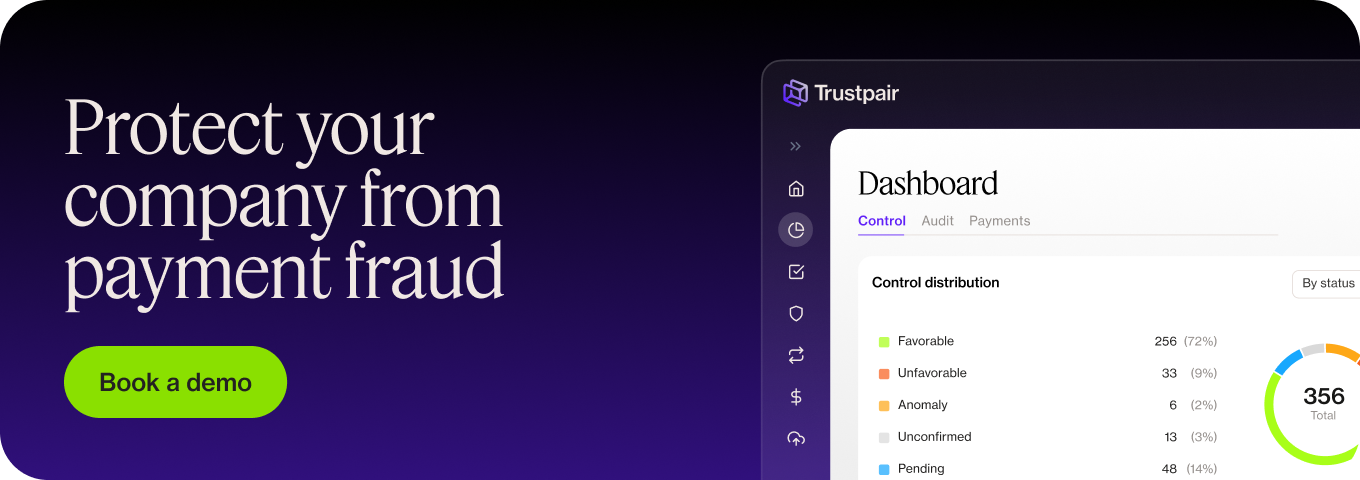Remote work, year-end book closings, and holiday schedules… Winter break remains a prime time for payment scams. Without the right prevention measures, your company could be at risk. Stay ahead this holiday season with insights from financial professionals, AFP experts, and feedback from our clients to safeguard your operations as we step into 2025!
Trustpair wipes out payment fraud thanks to automated account validation. Request a demo to learn more!
Payment Fraud: Key Data
In 2023, payment fraud incidents surged, with 80% of organizations reporting being targeted, reversing a previous downward trend. Larger organizations, particularly those with annual revenues exceeding $1 billion, were more frequently targeted, with 83% experiencing payment fraud attempts.
Many of these attacks involved Business Email Compromise (BEC) and other sophisticated methods. These developments were discussed during the 2023 AFP Conference, where treasury experts highlighted the increasing risk of payment fraud for businesses and emphasized the need for advanced fraud prevention strategies
Payment Fraud: What? Who? How?
Chris Buyers, Sr. Product Manager at PNC, shared with us an edifying example of what a payment fraud can look like. Chris told us the true story of a client, in which a criminal impersonated the CEO of a European aeronautical company to request a €42 million wire payment for an “acquisition project”. Before they realized it was a scam, the company executed the wire transfer and lost €42 million. What happened next? Both the CEO and CFO of the company were fired.
Unfortunately, this is not an isolated case. It can involve many different stakeholders within an organization, with the most likely targets being the Accounts Payable and the Treasury departments.
“Fraudsters are using social media, Linkedin.. they are able to map your entire organization, they are sending notes to the people in Treasury, they try to get you to give them passwords. When your email or password is compromised, they can get into your bank account.” says Frank d’Amadeo, Director of Treasury Operations at Con Edison. Indeed, fraudsters try to appear as trustworthy and legitimate as possible. Linkedin can be a great source of data for them, but they will also analyze your email signature and imitate the font, among other techniques. “They even knew my favorite color!” adds Kathy Mertes, Vice President of Digital Payments Strategy and Solution at Conduent.
Money laundering, also known as the process of concealing the proceeds of illegal activity, is also a serious global issue that affects financial institutions, governments, and individuals alike. The practice involves taking illicit funds and making them appear legitimate by moving them through a complex web of transactions and accounts. In recent years, there have been several high-profile cases of fighting money laundering, such as the scandal involving the Panama Papers.
Why is payment fraud particularly a threat during the winter holidays?
At Christmas, fraudsters don’t rest—quite the contrary. Vacations, remote work, tax season: the holiday season puts a lot of pressure on finance departments. They have to juggle many priorities, often with fewer staff members. That’s where fraudsters come into play: by taking advantage of security loopholes and overwhelmed finance teams. Unfortunately, finance departments easily miss out on red flags and can be victims of fraud in no time.
Attacks multiply at this time of year, and the damage caused – both financial and human – can be devastating. Corporations need to strengthen their internal control processes, without neglecting awareness and training.
How to prevent payment fraud within your company?
According to Lynn Cirrincione, Director of Cash & Banking Operations at Allstate:“Every single person in the organization must know what the fraud schemes are.” It is important to empower your employees to question suspicious emails or payment requests. However, educating is not enough and fraud can come from anywhere, at any time. Frank D’Amadeo testifies: “Recently, we lost $80,000 in one of our subsidiaries. The supplier they were dealing with got hacked. They failed in identifying a change in payment instructions.”
Bank account ownership verification requires manual cross-checking of multiple data sources, resulting in a high risk of error. “We have to be diligent to make sure we know our payees” says Kathy Merthes.
So what does it take to be best in class in fraud prevention? Here are our 5 top tips.
- Do not pay your suppliers in a hurry
- Protect your supplier files against data theft
- Automate your supplier data checks
- Monitor all controls continuously
- Raise awareness among all teams involved in the Procure 2 Pay process
Eliminating the risk of fraud within your organization is really about regaining control over your supplier data from the moment you integrate it into your system until the payment is executed. There would be much more focus on value and revenue growth if finance departments had more peace of mind.
Trustpair is the leading payment fraud prevention platform for large corporations. We secure your B2B payments throughout the Procure-to-Pay process by providing continuous, real-time international account validation. To prevent payment fraud, we recommend that you work with accurate supplier data in your systems. Contact us to prevent fraudulent B2B payments in your organization.






